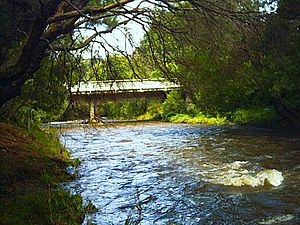Wainuiomata River facts for kids
The Wainuiomata River flows southwest through the Wainuiomata Valley. This valley is found in the southern part of the Remutaka Range on the North Island of New Zealand.
What Does Wainuiomata Mean?
The name Wainui-o-Mata comes from the Māori words wai (water), nui (big), o (of), and Mata. Mata might be a woman's name.
People have different ideas about where the name came from. One popular story says it's about women who crossed the Wainuiomata Hill. They were trying to escape from tribes attacking from the north. The story says they cried by the river after their men were killed. This led to the meaning "faces streaming with water" or "tears."
However, the name could also describe the large pools of water that once covered the swampy northern part of the valley. It might also refer to the river itself, which can flood the Wainui (Coast Road) valley.
Today, people often call it the "Wainui River." This is because the nearby area of Wainuiomata is also informally called "Wainui."
History of the Wainui River
The first settlements in the area grew up around the river. Timber mills here supplied wood to the Wellington region. There was a big need for timber in the 1850s and 1860s. Today, this area is known as "The Village" or "Homedale."
In 1879, people in Wellington voted to get more water for their city. By 1884, a dam was built in Sinclair Valley, also known as Waterworks Valley. A pipeline then carried water across the Wainuiomata Valley floor. It went through a tunnel under a hill and on to Wellington.
This first dam was replaced in 1910 by the Morton Dam, which is no longer used. Later, a tunnel and pipelines for the Orongorongo River were added by 1926. Setting up these waterworks also brought the telephone to the area. However, by 1921, only two people had phones!
Today, the Wainuiomata/Orongorongo Catchment Area is a restricted zone. This means you can't just go there. It's protected because it supplies a lot of the drinking water for the Wellington region.



